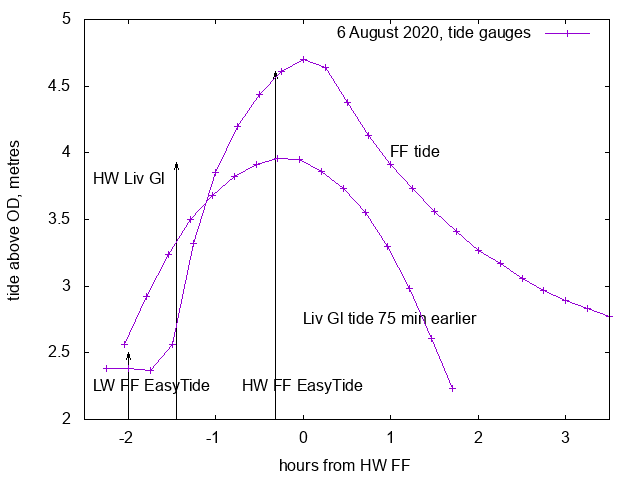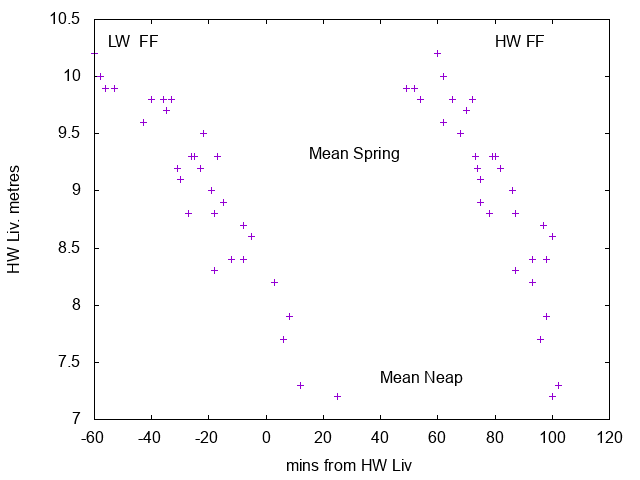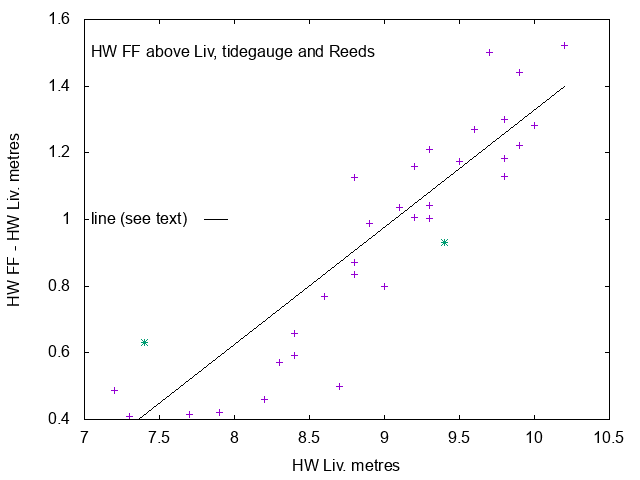
On my trip up to Fidlers Ferry on 6 August 2020, I noticed that the tide was lower that I expected. I used the tidegauge results (from the Fidlers Ferry gauge - presumably located on the riverside (pump?) building just above the boatyard and Ferry Tavern).
See here:

This shows that the rough guide - namely to use Liverpool (Gladstone) tide
75 minutes earlier - was a poor approximation, especially around HW (Liv) when the depth was
lower than I anticipated.
Note that the Navionics App shows tidal times and heights at
Fidlers Ferry (from EasyTide, so reasonably accurate) and also shows a
graph of tide over a day - which is very misleading and should not be
used.
I collected the tide gauge results for most of that month, together with the Liverpool(Gladstone) tides (from POLTIPS-3):
Times of LW and HW at Fidlers Ferry (FF) compared to HW at Liverpool (Gladstone) -
as HW Liverpool varies from neap (at bottom) to springs (at top):

This shows that HW FF can be 45 minutes after HW(Liv) for the biggest tides,
while as much as 100 minutes afterwards for the smallest tides. Also LW
FF can vary from 60 minutes before HW(Liv) to 20 minutes afterwards. LW
is the end of a long LW stand and the tidal height then increases rapidly from this
LW time until HW.
I also collated the depth difference (between HW FF and HW Liverpool) - as
HW (Liv) varied (neap at left, springs at right).

The asterisks are values from Reeds for neap and spring respectively.
What these plots show is that HW and LW times at FF vary considerably from
neap (where tide barely reaches to FF) to springs (where tide arrives much
sooner). Also the HW depth is not, as expected, the same as at Liverpool, but
significantly higher - by around 20% - 30% of the HW - ML at Liverpool. So
difference of 0.4 m at mean neaps, 1.1 m at mean springs, from the tidegauge
data; my plotted line has
HW(FF) - HW(Liv) = (HW(Liv)-6.22)*0.352.
I have only used data from one month - but it does have very high as well as very
neap tides. Other factors such as the volume of fresh water coming down the river
and weather factors (storm surges, etc) will also modify the tidal regime
up river.
Note that for very large tides, especially when there is little fresh water flow, there can be a bore on the Mersey - which occurs at LW when the incoming flood builds up to an abrupt increase. As the plots show, at Fidlers ferry, this will be about 60 minutes before HW Liverpool.